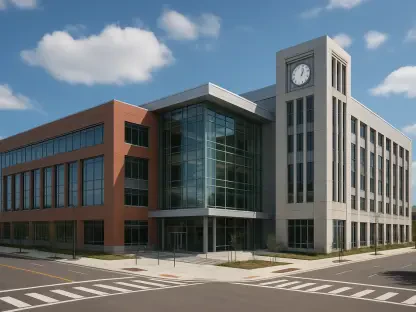The landscape of infrastructure development is being radically transformed by the integration of geospatial data with Building Information Modeling (BIM). This synergy, epitomized by tools like ArcGIS GeoBIM and ArcGIS Velocity, provides a comprehensive framework for managing large-scale projects. While the initial application of these tools is within the construction phase, their benefits extend far beyond, proving invaluable in the realms of operations and maintenance.
The Power of Data Integration
Combining geospatial data with BIM data through applications like ArcGIS GeoBIM brings a heightened level of visualization and management to infrastructure projects. This comprehensive approach significantly reduces errors and enhances coordination efforts by bridging disparate data and systems. Firms like HNTB have capitalized on ArcGIS GeoBIM to demonstrate that the utility of these integrated technologies surpasses the construction period, ensuring long-term operational effectiveness and accuracy.
The ability to connect various data types and systems into a unified platform not only enhances the accuracy of the information but also streamlines the entire workflow. This integration allows for more informed decision-making and better project outcomes. It is no longer necessary to constantly translate data from different formats, which often leads to inefficiencies and inaccuracies. Instead, ArcGIS GeoBIM provides a seamless experience that preserves data integrity and boosts overall productivity.
Real-Time Monitoring with ArcGIS Velocity
The integration of ArcGIS Velocity enriches the project’s functionality by introducing real-time monitoring through sensor data. This capability is crucial for projects such as the Walk Bridge replacement, where metrics like tilt, movement, and temperature are continuously monitored. The consistent data flow is indispensable for ensuring that infrastructure remains stable and safe throughout the entire construction process and beyond.
Real-time data from ArcGIS Velocity creates a continuous feedback loop that enhances safety and operational efficiency during the project lifecycle. Sensor data can provide immediate insights into the condition of the infrastructure, enabling quick responses to any issues that arise. This proactive approach to monitoring dramatically improves the level of safety and reliability, ensuring the infrastructure is built and maintained to the highest standards.
Addressing Data Translation Challenges
One of the persistent challenges in managing large infrastructure projects is the need to translate various data formats into usable information for all stakeholders involved. ArcGIS GeoBIM effectively addresses this issue by offering a unified platform where different data types, such as CAD and GIS, can be seamlessly integrated. This solution eliminates the need for repeated data translations, which often leads to errors and lost efficiency, ensuring the accuracy and reliability of the data throughout the project.
The collaborative tools provided by ArcGIS GeoBIM allow for synchronized data usage, resulting in better project outcomes. The successful partnership between Autodesk Construction Cloud products and ArcGIS GeoBIM exemplifies this integrated approach, showcasing how the technologies work in harmony to streamline workflows and improve overall project management. By maintaining data consistency and minimizing translation errors, these tools significantly enhance the efficiency and accuracy of infrastructure projects.
Advantages of Visualization and Collaboration
The adoption of digital twins—a 3D model that accurately represents real-world scenarios—offers distinct advantages during the design and construction phases. In the case of HNTB’s management of a large passenger terminal upgrade at an international airport, a digital twin built with ArcGIS GeoBIM facilitated improved collaboration among stakeholders. By visualizing potential design impacts on existing infrastructure, particularly regarding underground utilities, stakeholders can make more informed decisions.
Digital twins serve as a powerful tool for complex infrastructure projects, allowing stakeholders to see a detailed and accurate representation of the current state of the project. This level of visualization helps prevent potential issues and enhances overall project efficiency. As a result, the technology ensures better-informed decisions are made throughout the project lifecycle, contributing to smoother operations and successful completions.
Seamless CAD, GIS, and BIM Data Management
ArcGIS GeoBIM excels at managing GIS, CAD, and BIM data through one cohesive interface, effectively eradicating data silos and streamlining the design process. Stakeholders can access live working files and up-to-date maps effortlessly, facilitating superior coordination and communication. The robust integration of these varied data streams ensures a more cohesive workflow and better project outcomes for all involved.
The smooth data management provided by ArcGIS GeoBIM enhances the efficiency of design and construction processes, enabling project teams to work more collaboratively and cohesively. By unifying multiple data sources and allowing for seamless access, ArcGIS GeoBIM stands as a cornerstone for better integration and improved overall project management.
Ensuring Stability During Construction
For high-stakes projects like the Walk Bridge replacement, maintaining the stability of existing structures during construction is of utmost importance. Integrating ArcGIS Velocity with GeoBIM provides real-time monitoring of critical stability metrics, ensuring that any deviations can be quickly and efficiently addressed. This real-time monitoring capability not only ensures safety during construction but also offers a robust system for ongoing operations and safety management.
The technology’s ability to handle real-time data makes it an indispensable tool for infrastructure management, providing continuous insights into the current state of the project. This proactive approach to stability ensures that construction projects maintain the highest standards of safety and reliability, mitigating potential risks before they escalate into significant issues.
Extending Monitoring to Operations and Maintenance
The integration of geospatial data with Building Information Modeling (BIM) is ushering in a significant transformation in the field of infrastructure development. Tools like ArcGIS GeoBIM and ArcGIS Velocity exemplify this powerful combination, offering a robust framework for effectively managing large-scale projects. While these tools are primarily deployed during the construction phase, their utility goes well beyond that. They prove to be extremely beneficial in the areas of operations and maintenance as well. This convergence allows for a more comprehensive and streamlined approach to infrastructure management, making it easier to handle complex projects from inception to completion and beyond.
The adoption of these advanced tools marks a shift towards smarter, data-driven decision-making processes. By integrating detailed geographic information with intricate building models, stakeholders can visualize and analyze data in a way that was previously unimaginable. This holistic perspective not only improves accuracy and efficiency during construction but also enhances the ability to manage infrastructure assets throughout their entire lifecycle. This innovative integration, thus, represents a significant leap forward in the way infrastructure projects are planned, executed, and maintained.









